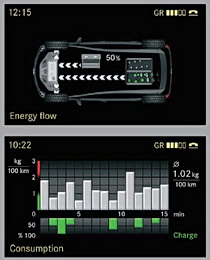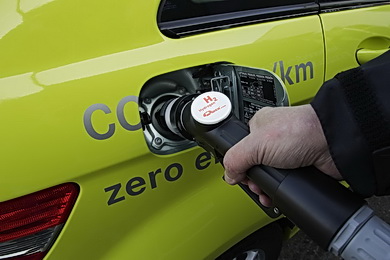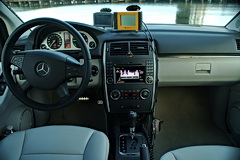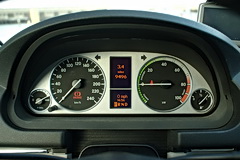By Derek Mau
Likes:
- Zero emissions
- Fuel cell technology suitable for larger vehicles
- Does not require any special service intervals or parts
Dislikes:
- Loud electrical hum from motors
- Cost of fuel-cell cars higher than hybrid cars
- Range limited not by size of hydrogen tank, but tied to location of H2 fueling station
As part of the ceremony to mark the 125th birthday of the invention of the motor car, Mercedes-Benz is promoting their B-Class F-CELL car with a drive across the world as means of promoting the benefits and advantages of fuel-cell technology. Three production (not concept) B-Class F-CELL cars are crossing the globe to prove that fuel-cell cars can be a good alternative to relieving our dependence upon fossil fuels and operate like any other car on the road today. I was fortunate to drive one of the B-Class F-CELL cars when the caravan stopped in San Francisco for fresh Dungeness crab and warm sourdough bread at Fisherman’s Wharf.

Setting out from Stuttgart on January 30, three Mercedes-Benz B-Class vehicles featuring zero-emission fuel cell drives are undertaking a 125-day circumnavigation of the world. Traveling across four continents and through 14 countries, the three B-Class F-CELL vehicles will head around the globe once, finishing their “world tour” back in Stuttgart where they started. With the F-CELL World Drive, Mercedes-Benz is aiming to confirm the technical maturity of fuel cell technology, as well as the suitability for everyday use of the vehicles. So far the F-CELL World Drive has already driven more than 3600 km (2200 miles) on the roads of Europe.
While the World Drive team was slurping their clam chowder from sourdough bowls, I snatched the key to one of the F-CELL cars and pulled one of the engineers away from her steaming bowl of soup. After a quick familiarization and a crash course in fuel cell technology by Dr. Christian Mohrdieck, Director of Fuel Cell Battery Development, I was given free rein to hum along on the inner streets of San Francisco and surrounding freeways. With a range of approximately 250 miles on 8.8 pounds (4 kilograms) of hydrogen fuel, I barely got the fuel gauge needle to move after my brief 15 mile journey in and around the city.
How different is driving a car fueled by hydrogen compared to a fossil-fuel burning, air polluting, personal all-about-me carriage? Not much, except finding a hydrogen fueling station is harder than getting Barry Bonds to admit he knowingly took steroids. The B-Class F-CELL drives like a car with fuel efficiency as its primary goal – slow and very modest. Powered by an electric motor with 136 horsepower and 215 lb-ft of torque, the new B-Class F-CELL provides driving performance comparable to a similar conventional car and has a top speed of over 100 mph. Zero to 60 took an excruciating 11 seconds and a very long freeway on-ramp. While the B-Class F-CELL electric motor does have to work really hard to initiate quick off-the-line launches and passing maneuvers, uphill performance is no worse than a Prius.
Inside the cabin four passengers can sit comfortably and are surrounded by a no-frills interior with cloth seats. Americans associate high luxury standards with Mercedes vehicles, but the B-Class has very little to meet those expectations. Interior trim is basic and a lot of the plastic pieces that comprise the dashboard are hard to the touch. Instrumentation is adapted to fuel cell specific requirements. The control system COMAND APS is supplemented with an energy flow diagram of the propulsion system which also keeps the driver informed about current fuel consumption. The integrated navigation system easily guides you to the next hydrogen fueling station – even if it is 10 zip codes away.


Next year, Daimler will build 200 B-Class F-CELL cars and distribute them in Europe and California. Interested parties that want cleaner air quality and a clean environmental conscience can lease F-CELL cars from Mercedes-Benz. It also helps if you live in area where there are public hydrogen fueling stations. I counted only fourteen hydrogen fueling stations in North America with public access and six of those are located in southern California. And that explains why 70 B-Class F-CELL cars will find their way to SoCal in 2012.
2011 Mercedes-Benz B-Class F-CELL Specs
- MOTOR: high capacity electric motor
- PEAK POWER: 136 HP (100 Kilowatts)
- NET POWER: 95 HP (70 Kilowatts)
- TORQUE: 215 lb-ft (290 Nm)
- TRANSMISSION: CVT
- FUEL CONSUMPTION: (0.97 kg H2 /100 km)
- RANGE: approximately 250 miles (400 km)
###
 2011 Mercedes-Benz B-Class F-CELL Specs |
|
|
|
|
 Official website for Mercedes-Benz cars, hybrids, and SUVs – www.mbusa.com Official website for Mercedes-Benz cars, hybrids, and SUVs – www.mbusa.com |
|





The chartreuse green and decals call attention to the fact that these B-Class cars are using hydrogen as a clean fuel source. While B-Class cars are easily lost among the multitude of compact cars, the paint scheme made you look and take notice.
There are a few car companies putting R&D money into fuel cell cars (BMW, Honda, M-B to name a few). What fuel cell cars need is a big boost in consumer awareness if they are going to get any traction with government support and public attainability.
My name is Adam and being a gay male, I find environmental concerns are becoming more important to me and my life partner. I don’t want my adopted chinese, and african, children to grow up in a smoggy planet!
Oh please tell me they are going to ship in that vomit green color. I’d love be sitting by the side of the road laughing my ass off at anyone driving by in one.
Oh please will Merc grant my wish!?